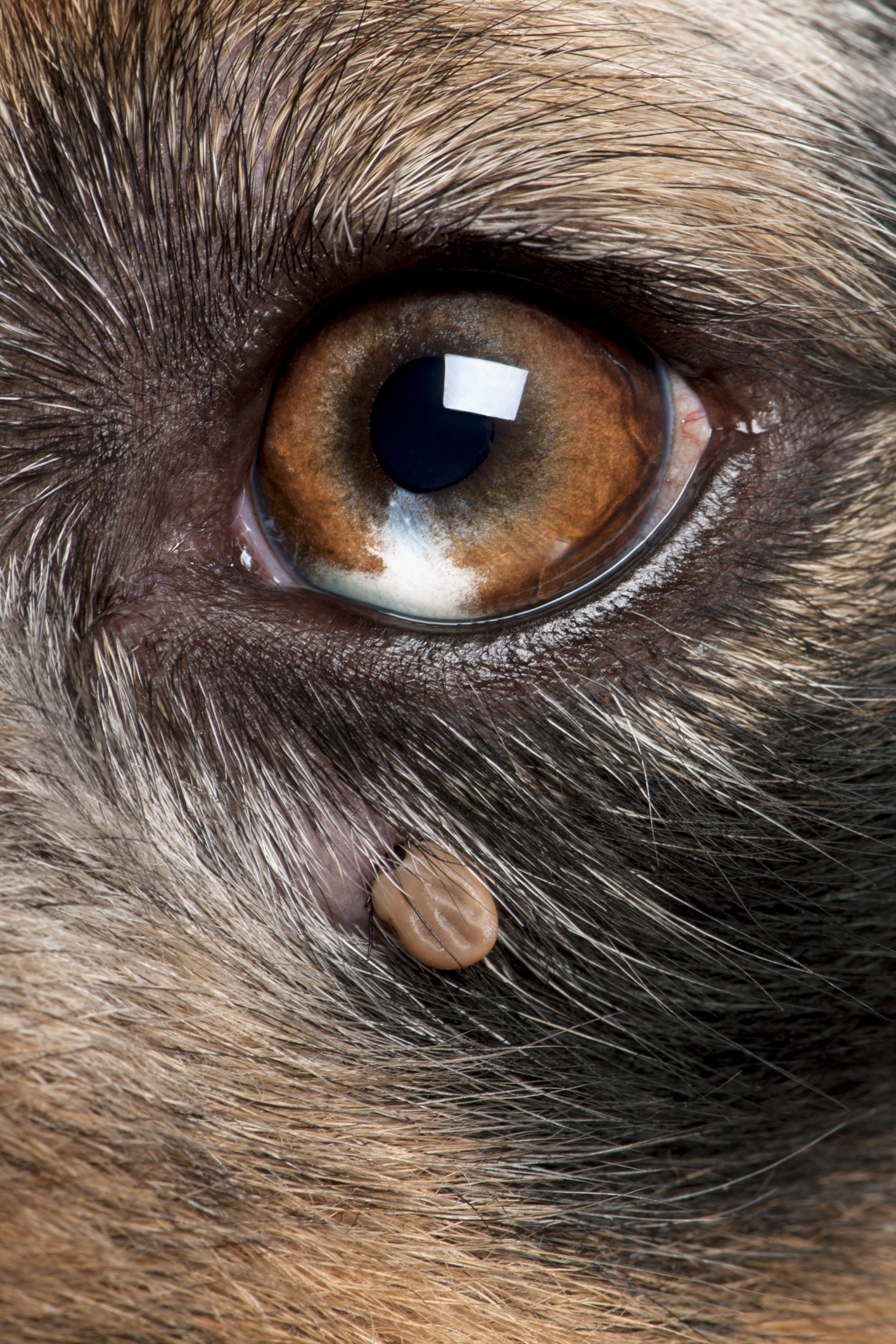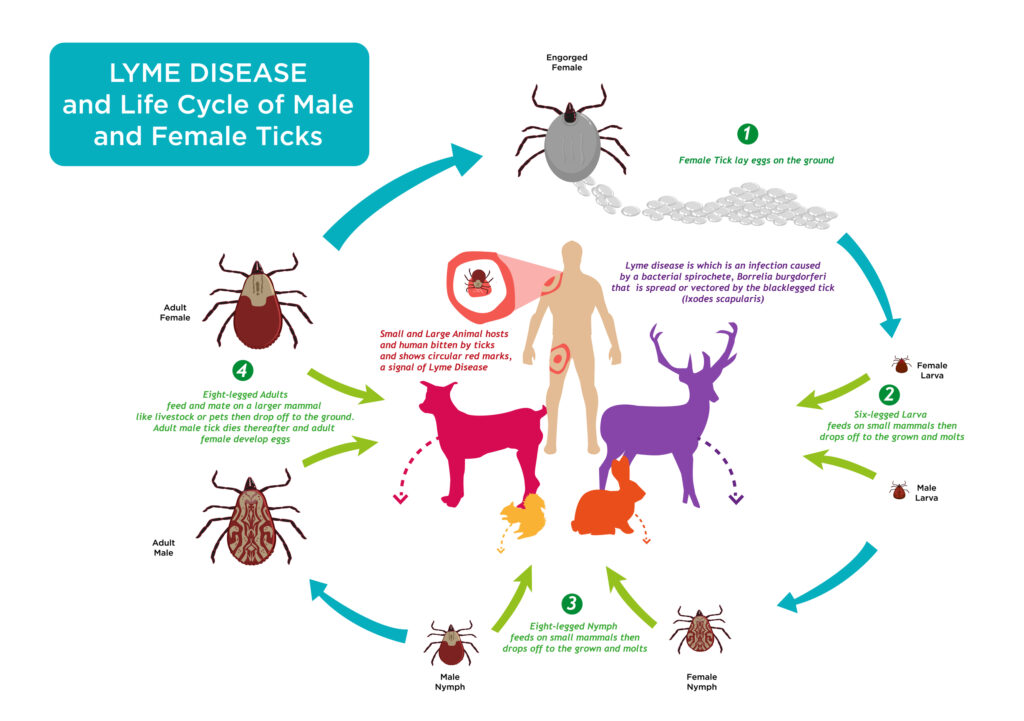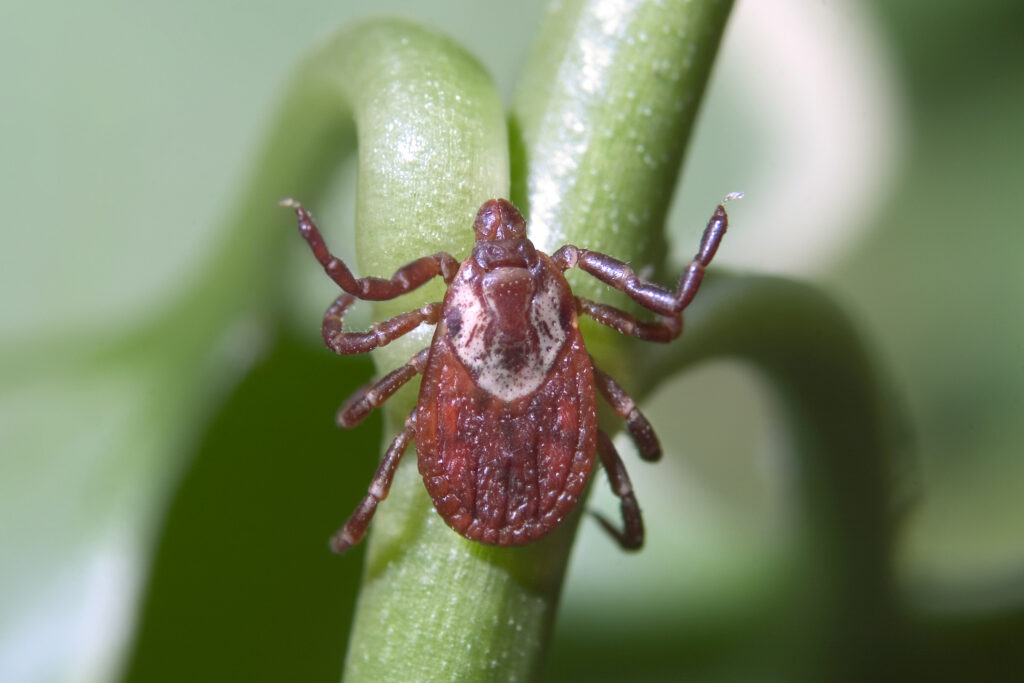This article was originally submitted as part of Kamrin MacKnight’s final project for the Diploma in Aromatic Science at the Tisserand Institute.
Ticks and the diseases they transmit present significant health challenges to humans and other animals. Indeed, ticks are the most important vectors of vector-borne diseases of humans and other animals (Boulanger et al. 2019). Despite the disease risk, some people, including those who enjoy outdoor activities with their dogs, are unwilling or unable to utilize commonly recommended repellents on themselves and/or their dogs, either due to sensitivity to the repellent components or a preference to avoid “harsh chemicals” (Rotkin-Ellman & Solomon 2009). Thus, for some, essential oils present a potentially beneficial and attractive option to avoid tick bites. Based on the number of websites and other advertisements promoting the use of essential oils as repellents, this is an increasingly popular use of essential oils with humans and our companion dogs.
Background
Ticks are blood-feeding, parasitic arthropods, serving as carriers of several diseases. Ticks are vectors of a greater diversity of disease-causing human pathogens than any other arthropod (Boulanger et al., 2019; Ginsberg & Faulde, 2008; Sonenshine, 2018; Wikel, 2018). In addition to causing significant morbidity, various tick species are responsible for devastating economic losses in the livestock industry (Flor-Weiler et al. 2022).
In the US, Lyme disease (caused by Borrelia burgdorferi) is primarily transmitted by black-legged or “deer” ticks, Ixodes scapularis or I. pacificus (Ginsberg & Faulde, 2008). Dermacentor variabilis (“dog” tick) is another common tick in North America, known to transmit the bacteria responsible for various diseases, including Rocky Mountain spotted fever and tularemia. Additional tick-borne diseases include babesiosis, rickettsiosis, ehrlichiosis, bartonellosis, anaplasmosis, Powassan virus disease, Borrelia miyamotoi disease, theileriosis and tick-borne relapsing fever. Tick bites can also lead to substantial blood loss, toxic reactions, and even death (e.g., due to paralysis).
Partially due to climate change, the worldwide occurrence of tick-borne diseases continues to increase annually (Danta-Torres 2015; Gardner et al. 2020; Pantchev et al. 2015; Pickett et al. 2023). Indeed, while mosquitoes arguably present the largest disease risks (malaria), ticks play a significant role in animal morbidity and reduced production, particularly in areas with limited resources to address the issue (Wanzala et al. 2018; Madzimure et al. 2013).
A complicating factor in eradication approaches is that ticks can survive many months and even years without feeding, due to their extremely low resting metabolic rates and diapause (phase of suspended development) (Lighton et al. 1994). Thus, the timing of repellent use is usually dependent upon active tick questing and/or feeding behavior. Historically, most disease-vector ticks have had well-defined geographic ranges, and many are constrained by long-evolved host-parasite relationships (Sonenshine, 2018). However, this is changing, as some tick ranges have expanded, representing potentially increased risks for tick-borne disease spread (Sonenshine, 2018; Eisen & Eisen 2018). The increasing number of pathogenic microorganisms reported to be transmitted by ticks such as I. scapularis, raise additional concerns (Eisen & Eisen, 2018). In sum, there is an increasing need for cost-efficient, efficacious, “green,” and safe tick repellents for humans and other animals.
Historically, repellants utilized synthetic chemicals. Initially, arsenic and arsenical derivatives were extensively used. These were replaced with various organochlorines (e.g., dichlorodiphenyltricholoroethane , benzene hexachloride , lindane, dieldrin, and toxaphene), which were then replaced with other compounds (George, 2006; Selles et al. 2021). For over 50 years, DEET (N,N-diethyl-3-methdylbenzamide) has been the most extensively used repellent, as it is highly effective against several mosquitoes, biting flies, chiggers, and to some extent, ticks. Permethrin and piperidines are generally considered to be more repellent for ticks than DEET, although DEET is generally viewed as the “gold standard” repellent. However, DEET reacts with some synthetic materials, the skin-feel can be objectionable, and adverse reactions have been reported (Bissinger & Roe, 2010). In addition to environmental and public health concerns, ticks have become increasingly resistant to commonly used chemicals, representing an additional challenge.
In 1986, the US Environmental Protection Agency (EPA) amended the Federal Insecticide, Fungicide and Rodenticide Act (FIFRA), to exempt from regulatory requirements compounds considered to be minimum risk pesticides. These include essential oils of cedarwood (most types) citronella, clove, geranium lemongrass, peppermint, rosemary spearmint and thyme. The subsequent searches for “green pesticides” for public health and environmental benefits appear to have resulted in numerous studies on essential oils and their components for repelling/killing ticks and other pests (Koul et al. 2008; Norris et al. 2018; Rand et al. 2010).
Commercial products and DIY repellents
In addition to commercially available tick repellents, there are numerous essential oil “recipes.” The accompanying spreadsheet lists nine commercially available repellents and 13 formulations posted on the internet for use with canines (identified in a Google search), including the essential oils listed in the products. The only commercially available repellents that include the botanical name of the essential oils are two preparations available from Animal EO.
Of the formulations reviewed, all five included on the Raising Your Pets Naturally website give links to suppliers that list the botanical names of the essential oils in the tick repellents. Cedarwood (C. atlantica) and citronella (C. winterianus) oils are the main ingredients in these formulations. Of the others, lavender and turmeric are the most common oils listed, followed by lemongrass and eucalyptus. Some of these formulas include a large number of oils (almost certainly not necessary) and many include water as a diluent. Some have carrier oils (e.g., sweet almond or coconut oil), while some include vinegar or witch hazel. In some instances, the formulas do not facilitate proper dispersion of the essential oils, which can lead to adverse reactions when used.
Assays for tick repellency
Most of the published investigations into the use of chemicals, including essential oils and/or essential oil compounds to repel ticks, have utilized in vitro methods. However, in vivo methods using volunteers and non-human animals have been reported, as well as field experiments (e.g., dragged clothing methods). Adenubi et al. (2018) provide detailed descriptions of various in vitro methods used to assess the effects of chemical substances on ticks. There are repellency, as well as expellency and deterrency assays. Tick repellents cause ticks to move away from the chemical, while deterrents inhibit feeding in situations where feeding would normally occur. Tick expellency is caused by any stimulus that makes ticks fall off the host animal, either by causing detachment of attached ticks or by preventing attachment of the ticks to the host. While there are many strategies to assess tick behaviors, most of the published studies and those reviewed herein, focus on tick repellency.
One consideration in assessing the published reports is the source of the ticks. Laboratory-raised ticks have the advantages of being pathogen-free and having predictable behavior patterns. But, these ticks have not had previous exposure to any chemicals intended to kill or repel. Wild-harvested ticks may harbor pathogens, limiting their use with volunteers, and their behavior may be somewhat unpredictable. In addition, wild-harvested ticks may have experienced environmental exposure to acaricides and other chemical compounds that could impact their response to the tested essential oils. Another consideration is that some studies utilize engorged females with mature eggs, some use non-engorged females, and others use larvae or nymphs. In addition, different tick species have been shown to have different susceptibilities to the same repellent (Bissinger & Roe 2010).
Furthermore, there is a lack of protocol uniformity, including temperature and humidity conditions; assay standardization would facilitate comparison of the results from different studies (Benelli et al. 2016). Attempts have been made to standardize methods (Marchiondo et al. 2007; Kröber et al. 2013; EPA Final Guideline 810.3300), but even published methods are not used consistently worldwide and there are discrepancies reported between them.
There are other issues related to assay protocols. For example, in an EPA protocol, the test tick is placed on untreated skin. When it approaches the border of repellent-treated skin, the tick can choose to remain on the untreated skin or walk onto the treated skin. Ticks tend to walk or climb up when placed on a host. Thus, the repellent only needs to counter the ticks’ natural motivation to move upwards, as the tick has the option of staying on untreated skin. In another assay – the Stiftung Warentest (StiWa) – the tick is placed on a copper plate that is surrounded by repellent-treated skin. In this assay, the tick can decide to stay on a surface that is unsuitable for attachment (i.e., the copper) or walk onto the repellent-treated skin. There are also mechanical issues with the test (e.g., maintaining the copper plates in place).
In addition, the reagents used in some assays have been found to be detrimental. For example, a report of experiments using the Petri dish bioassay with hexane as a solvent, some ticks were found dead during the protocol, indicating that hexane was toxic to the ticks (Barrozo et al. 2021). Repellent efficacy over time is another consideration in comparing studies. In sum, it can be difficult to compare the assay results from different published reports due to protocol differences (Dautel et al. 2013). Other issues that make comparisons difficult (Ellse & Wall 2013), include batch variation in oil constituent concentrations. In some cases, appropriate positive and negative controls aren’t utilized. Also, if direct contact assays are used to assess the toxicity pathway of an essential oil, it is important to use a hydrophobic control, as it is impossible to distinguish neurological or other cellular toxicity from simple mechanical effects without this control.
Publications on the use of essential oils as tick repellants
A search for “essential and oil and tick” in the Springer Verlag journal and book database identified 7,049 publications, while a search “essential oils and ticks” found 6,977 publications, while a search for “essential oils and Ixodes ticks” listed just 441. Due to time and resource constraints, only a limited selection of these and other publications were reviewed.
In addition to assessing the effectiveness of essential oils to repel ticks on skin or fur, studies have looked at essential oils as tick repellents on clothing (Soutar et al. 2019), an option relevant to repellent selection. In addition to reports of specific experiments, there are many review papers (Benelli et al. 2016; Benelli & Pavela, 2018; Bissinger & Roe, 2010; Nwanade et al. 2020; Roeber & Webster 2021; Rosada-Aguilar et al. 2017; Selles et al. 2021); Tavares et al. 2018). Despite this fairly large number of publications, the amount of research on tick biology is much less than that dedicated to mosquitoes, potentially making tick research less conclusive (Bissinger & Roe, 2010; Faraone et al. 2019).
One study compared the repellency of DEET and eight commercially available essential oils against A. americanum (lone star) tick nymphs (Meng et al. 2016). The botanical names and sources of the essential oils are provided, as well as a description of the vertical filter paper bioassay. While DEET was found to be more effective than all of the essential oils, some of the oils were found to have some repellency. The descending order of effectiveness was oregano (Origanum vulgare) > clove (Eugenia caryophyllata) > thyme (Thymus satureioides) > vetiver (Chrysopogon zizanioides) > sandalwood (Santalum album) > cinnamon leaf (Cinnamomomum zelanicum) > cedarwood (Cedrus atlantica) > peppermint (Mentha piperita).
In contrast, a USA study reported that Virginian cedarwood (Juniperus virginiana) CO2 extract provided a useful degree of repellency and toxicity toward nymphs of four tick species (Flor-Weiler et al. 2022). I. scapularis nymphs were found to be most sensitive to the extract in repellency assays, while A. americanum nymphs did not exhibit the same morbidity characteristics as the other three species. But, the toxicity assays indicated all four species were susceptible.
Another report (Luker et al. 2023) indicates that among a selection of oils purchased from Millipore Sigma, cinnamon and clove are effective tick repellents, but fatty oils (soybean, castor, linseed, cottonseed, and sesame) did not repel mosquitoes or ticks. The studies used adult female lab-raised I. scapularis ticks tested using the US EPA’s tick-on-arm crawling assay. Unscented lotion with 10% DEET provided the longest protection (up to 6 hours). However, 10% lotion formulations with clove oil, cinnamon leaf oil, 2-phenylethyl propionate, and geraniol provided protection for longer than one hour, and 10% thyme oil provided protection for 55 minutes. Other oils (cedarleaf, citronella, cornmint, garlic, geranium, lemongrass, peppermint, rosemary, and spearmint) did not provide protection that was significantly different from untreated and unscented lotion controls.
One report (Jaenson et al. 2006) addresses the repellency of lemon eucalyptus oil, geranium oil, lavender oil, and the mosquito repellent MyggA Natural (a repellent for blood-feeding arthropods, containing 30% Corymbia citriodora oil comprising a minimum of 50% cis– and trans–p-menthane-3,8 diol , and L. angustifolia, and P. graveolens essential oils) in the field and laboratory. (Note that this is not a natural lemon eucalyptus oil, it has been manipulated to boost the PMD content from around 1.5% to 50%.)
Laboratory bioassays were conducted using field-collected I. ricinus nymphs. In the laboratory tests, 1,2-propanediol was used as a solvent, as it is the carrier used in MyggA Natural. The field trials used a cotton flannel cloth dragging method, as well as the application of tested repellents to cotton trouser legs. The laboratory bioassay results on the repellency of the oils were concentration- and time-dependent, as were the field results. While the essentials oils provided some repellency, 100% protection was not observed. In addition, the authors highlighted the need for research on extending the time of repellent efficacy, especially under wet conditions.
In another investigation, ten P. graveolens essential oils were assessed (Tabanca et al. 2013). One sample, found to repel >90% of A. americanum (L.) ticks at 0.103 mg/cm2 of filter paper was fractionated and the various components assessed for their repellency. A vertical filter paper bioassay was used to test laboratory-raised nymphs’ response to the test compounds. One component, a sequiterpene alcohol, (-)-10-epi-γ-eudesmol was identified as a potential commercially viable tick repellent. Other components were not as effective at repelling ticks, with isomenthone and linalool being ineffective at tested concentrations. The results indicated that the efficacy of (-)-10-epi-γ-eudesmol was as effective as DEET at concentrations > 0.052 mg of compound/cm2 of filter paper. However, DEET was found to retain its repellency at much lower concentrations. Nonetheless, the authors conclude that (-) -10-epi-γ-eudesmol is a potentially viable component for commercial tick repellent products. (This compound is found in amyris and geranium oils, both at a little under 10%.)
One study addresses the efficacy of balsam fir (Abies balsamea) needles and essential oil on killing overwintering ticks (I. scapularis) at cold temperatures under lab and field conditions (Adamo et al. 2022). Whole needle preparations, essential oil, and β-pinene were tested. Whole needle preparations required several weeks to kill wild-harvested or lab nymph and adult overwintering ticks, but the essential oil was found to be lethal within days, at temperatures less than or equal to 4°C. β-Pinene was also found to kill overwintering ticks. This study indicates that these oils are an option for tick control during winter conditions.
In one report, the repellency of 12 essential oils and two carrier oils were tested for their effect on nymphal wild-harvested I. ricinus ticks (Goode et al. 2018). In addition to in vitro assays, dogs were used in experiments to determine the efficacy of 2.5% (v/v) turmeric oil in deterring tick attachment to volunteer dogs. Orange oil (2.5%, v/v) was used as a negative control. Turmeric oil was reported to be effective in vitro and was reported as significantly more effective than orange oil at keeping ticks from attaching to the volunteer dogs’ legs/bellies. However, in addition to other experimental caveats, the number of ticks attached was determined by the dogs’ owners.
One paper describes studies of thymol, carvacrol, linalool and permethrin against I. ricinus larvae (Tabari et al. 2017). The authors conclude that carvacrol and thymol hold promise as potential compounds for tick control. However, they also indicate that other life stages (e.g., nymphs and adults) should also be tested, as these stages more frequently infest larger mammals. Furthermore, field trials, formulations and other studies are also needed to more thoroughly assess the acaricidal activity of these essential oil components.
The repellent and acaricidal activities of essential oils extracted from three basil (Ocimum basilicum L.) varieties were tested under laboratory conditions on nymph and adult female black-legged ticks (I. scapularis Say), and female adult American dog ticks (D. variabilis Say) (Wang et al. 2022). In addition, the combination of rock dust with these oils was tested, as immobilization of oils on various materials has been studied, to increase longevity and effectiveness. D. variabilis ticks were not affected by the oils, even at the highest tested concentrations (20% w/w) and 28 days post-treatment, although it is possible that nymphal and larval stages may be more susceptible. In contrast, I. scapularis adults and nymphs were susceptible to the oils. Additional studies, including field trials, encapsulation assays, nano-formulations are indicated as being urgently needed.
Conclusions
While there are some commercially available tick repellents as well as “do-it-yourself” recipes that contain essential oils, most do not provide sufficient information to make an informed choice of oils/combinations. There are discrepancies in reported experimental results on the repellency of various essential oils on ticks, as well as a lack of consistent reported efficacy of various oils and recipes. Furthermore, questionable controls, the paucity of reports using “standardized” tests, and other experimental issues, preclude a definitive statement that essential oils at specific concentrations and combinations are suitable for effective tick control. Although quantitative comparisons are somewhat problematic due to these inconsistencies, qualitative assessments are possible and point to the potential for the use of essential oils for tick repellency. Additional controlled tests and studies involving suitable concentrations of essential oils are needed. Nonetheless, there appears to be sufficient evidence that some essential oils are promising weapons to include in our arsenal against ticks and tick-borne diseases.
References
Adamo et al. (2022). Balsam fir (Abies balsamea) needles and their essential oil kill overwintering ticks (Ixodes scapularis) at cold temperatures. Scientific Reports, 12:12999.
Adenubi et al. (2018). In vitro bioassays used in evaluating plant extracts for tick repellent and acaridical properties: A critical review. Veterinary Parasitology, 254: 160-171.
Barrozo et al. (2021). Repellent and acaridical activity of coconut fatty acids and their derivative compounds and catnip oil against Amblyomma sculptum. Veterinary Parasitology, 300:109591 (https://doi.org/10.1016/j.vet.par.2021.109591).
Benelli et al. (2016). Tick repellents and acaricides of botanical origin: a green roadmap to control tick-borne diseases? Parasitology Research, 115: 2545-2560n
Benelli and Pavela (2018). Repellence of essential oils and selected compounds against ticks — A systematic review. Acta Tropica, 179:47-54.
Bissinger and Roe (2010). Tick repellents: Past, present and future. Pesticide Biochemistry and Physiolology, 96: 63-79.
Boulanger et al. (2019). Ticks and tick-borne diseases. Medécine et Maladies Infectieuses, 49:87-97.
Danta-Torres (2015). Climate change, biodiversity, ticks and tick-borne diseases: The butterfly effect. International Journal for Parasitology: Parasites and Wildlife 4:452-461.
Dautel et al. (2013). Efficacy testing of several Ixodes ricinus tick repellents: Different results with different assays. Ticks and Tick-Borne Diseases, 4:256-263.
Eisen and Eisen (2018). The blacklegged tick, Ixodes scapularis: An increasing public health concern. Trends in Parasitology, 34: 295-309.
Ellse and Wall (2014). The use of essential oils in veterinary ectoparasite control: a review. Medical and Veterinary Entomology, 28:233-243.
Faraone et al. (2019). Behavioral responses of Ixodes scapularis tick to natural products: development of novel repellents. Experimental and Applied Acarology, 79:195-207.
Flor-Weiler et al. (2022). Repellency and toxicity of a CO2-derived cedarwood oil on hard tick species (Ixodidae). Experimental and Applied Acarology, 86: 299-312.
Gardner et al. (2020). Landscape features predict the current and forecast the future geographic spread of Lyme disease. Proceedings of the Royal Society B: Biological Sciences, 287: 20202278 (https//doi.org/10.1098/rspb.2020.2278).
George (2006). Present and future technologies for tick control. Annals of the New York Academy of Science, 916:583-588.
Ginsberg, H., and Faulde, M. (2008) Ticks. In, Bonnefoy et al. (eds), Public Health Significance of Urban Pests, 1st ed., World Health Organization, Copenhagen, Denmark, pp. 304-345.
Goode et al. (2018). Preventing tick attachment to dogs using essential oils. Ticks and Tick-Borne Diseases, 9:921-926.
Jaenson et al. (2006). Repellency of oils of lemon eucalyptus, geranium, and lavender, and the mosquito repellent MyggA Natural to Ixodes ricinus (Acari: Ixodidae) in the laboratory and field. Journal of Medical Entomology, 43:731-736.
Koul et al. (2008). Essential oils as green pesticides: Potential and constraints. Biopesticides International, 4:63-84.
Kröber et al. (2013). A standardized in vivo and in vitro test method for evaluating tick repellents. Pesticide Biochemistry and Physiology, 107:160-168.
Lighton et al. (1994). Mass scaling of standard metabolism in ticks: A valid case of low metabolic rates in sit-and-wait strategies. Physiological Zoology, 58:43-62.
Luker et al. (2023). Repellent efficacy of 20 essential oils on Aedes aegypti mosquitoes and Ixodes scapularis ticks in contact-repellency assays. Scientific Reports, 13: 1705.
Madzimure et al. (2013). Efficacy of Strychos spinosa (Lam.) and Solanum incanum L. aqueous fruit extracts against cattle ticks. Tropical Animal Health and Production, 45:1341-1347.
Marchiondo et al. (2007). World Association for the Advancement of Veterinary Parasitology (W.A.A.V.P.) guidelines for evaluating the efficacy of parasiticides for the treatment, prevention and control of flea and tick infestation on dogs and cats. Veterinary Parasitology, 145: 332-344.
Meng et al. (2016). Evaluation of DEET and eight essential oils for repellency against nymphs of the lone star tick, Amblyomma americanum (Acari: Isodidae). Experimental and Applied Acarology, 68:241-249.
Norris et al. (2018). Present and future outlook: The potential of green chemistry in vector control, in Advances in the Biorational Control of Medical and Veterinary Pests, ACS Symposium Series. American Chemical Society, Wash. D.C., pp. 43-62.
Nwanade et al. (2020). Botanical acaricides and repellents in tick control: current status and future directions. Experimental and Applied Acarology, 81:1-35.
Pantchev et al. (2015). Tick-borne diseases (borreliosis, anaplasmosis, babesiosis) in German and Austrian dogs: Status quo and review of distribution, transmission, clinical findings, diagnostics and prophylaxis. Parasitology Research, 114 (Suppl) 1:S19-S54
Pickett et al. (2023). Common yarrow (Achillea millefolium) essential oil and main components as potential repellants and acaricides against Ixodes scapularis and Dermacentor variabilis (Acari: Ixodidae) ticks. Experimental and Applied Acarology, 89:287-303.
Rand et al. (2010). Trial of a minimal-risk botanical compound to control the vector tick of Lyme disease. Journal of Medical Entomology, 47:695-698.
Roeber and Webster (2021). Protecting dogs and cats against the Australian paralysis tick, Ixodes holocyclus (Acari: Ixodidae): A review of the Australian acaricide registration process. Current Research in Parasitology & Vector-Borne Diseases, 1:100054.
Rosada-Aguilar et al. (2017). Plant products and secondary metabolites with acaricide activity against ticks. Veterinary Parasitology, 238:66-76.
Rotkin-Ellman and Solomon (2009). Poison on Pets II: Toxic chemicals in flea and tick collars. Natural Resources Defense Council.
Selles et al. (2021). Acaricidal and repellent effects of essential oils against ticks: A review. Pathogens, 10:1379 (https://doi.org/10.3390/pathogens10111379).
Sonenshine (2018). Range expansion of tick disease vectors in North America: Implications for spread of tick-borne disease. International Journal of Environmental Research and Public Health, 15:478; doi:10.3390/ijerph15030478.
Soutar et al. (2019). Essential oils as tick repellents on clothing. Experimental and Applied Acarology, 79:209-219.
Tabanca et al. (2013). Bioactivity-guided investigation of geranium essential oils as natural tick repellents. Journal of Agricultural and Food Chemistry, 61:4101-4107.
Tabari et al. (2017). Toxic and repellent activity of selected monoterpenoids (thymol, carvacrol and linalool) against the castor bean tick, Ixodes ricinus (Acari: Ixodidae). Veterinary Parasitology, 245:86-91.
Tavares et al. (2018). Trends in insect repellent formulations: A review. International Journal of Pharmaceutics, 539:190-209.
United States Environmental Protection Agency (1999). Product Performance Test Guidelines OPPTS 810.3700: Insect Repellents for Human Skin, EP 715-C-10-001:see epa.gov).
United States Environmental Protection Agency (2021). OPPTS Product Performance Test Guidelines 810.3300: The Efficacy of Topically Applied Pet Products Against Certain Invertebrate Pests, EPA 712-C-21-002; see epa.gov).
Wang et al. (2022). Repellent and acaricidal activities of basil (Ocimum basilicum) essential oils and rock dust against Ixodes scapularis and Dermacentor variabilis ticks. Experimental and Applied Acarology, 86:583-598.
Wanzala et al. (2018). Essential oils of indigenous plants protect livestock from infestations of Rhipicephalus appendiculatus and other tick species in herds grazing in natural pastures in western Kenya. Journal of Pesticide Science, 91:395-404.
Wikel (2018). Ticks and tick-borne infections: complex ecology, agents, and host interactions. Veterinary Sciences, 5:60.
Additional References:
Birkett et al. (2011). Repellent activity of catmint (Nepeta cataria) and iridoid nepetalactone isomers against Afro-tropical mosquitoes, ixodid ticks and red poultry mites. Phytochemistry, 72:109-114.
da Silva et al. (2016). Efficacy of Tagetes minuta (Asteraceae) essential oil against Rhipicephalus sanguineus (Acari: Ixodidae) on infested dogs and in vitro. Experimental and Applied Acarology, 70:493-489.
El-Seedi et al. (2017). Essential oils of aromatic Egyptian plants repel nymphs of the tick Ixodes ricninus (Acari: Ixodidae). Experimental and Applied Acarology, 73:139-157.
Facey et al. (2005). Biological activity and chemical composition of the essential oil from Jamaican Hyptis verticillate Jacq., Journal of Agricultural and Food Chemistry, 53:4774-4777.
Figueiredo et al. (2018). First report of the effect of Ocotea elegans essential oil on Rhipicephalus (Boophilus) microplus. Veterinary Parasitology, 252:131-136.
Jia et al. (2018). Chemical composition and acaricidal activity of Arisaema anurans essential oil and its major constituents against Rhipicephalus microplus (Acari: Ixodidae). Veterinary Parasitology, 261:59-66.
Novato et al. (2015). Evaluation of the combined effect of thymol, carvacrol and (E)-cinnamaldehyde on Amblyomma sculptum (Acari: Ixodidae) and Dermacentor nitens (Acari: Ixodidae) larvae. Veterinary Parasitology, 212:331-335.
Novato et al. (2019). Evaluation of synergism and development of a formulation with thymol, carvacrol and eugenol for Rhipicephalus microplus control. Experimental Parasitology, 207:107774.
Paluch et al. (2010). Amyris and siam-wood essential oils: Insect activity of sesquiterpenes, in Peterson and Stout, Pesticides in Household, Structural and Residential Pest Management, ACS Symposium Series. American Chemical Society, Wash. D.C., pp. 5-18.
Paluch et al. (2011). Development of essential oil-based arthropod repellent products, in Paluch and Coats, Recent Developments in Invertebrate Repellents, ACS Symposium Series. American Chemical Society, Wash. D.C., pp. 151-161.
Park et al. (2021). Acaricidal and repellent activities of Litsea cubeba (Lour.) oil and 3,7-dimethyl-2,6-octadienal against Haemaphysalis longicornis (Acari: Ixodidae). Applied Biological Chemistry, 64:88.
Pirali-Kheirabadi et al. (2010). Lavandula angustifolia essential oil as a novel and promising natural candidate for tick (Rhipicephalus (Boophilus) annulatus) control. Experimental Parasitology, 126:184-186.
Ravindran et al. (2018). In vitro efficacy of amitraz, coumaphos, deltamethrin, and lindane against engorged female Rhipicephalus (Boophilus) annulatus and Haemaphysalis bispinosa ticks. Experimental and Applied Acarology, 75:241-253.
Ribeiro et al. (2008). Chemical composition and larvicidal properties of the essential oils from Drimys brasiliensis Miers (Winteraceae) on the cattle tick Rhipicephalus (Boophilus) microplus and the brown dog tick Rhipicephalus sanguineus. Parasitology Research, 102:531-535.
Shelton (2018). Animal Desk Reference II: Essential Oils for Animals, 2nd ed., available from www.AnimalDeskReference.com, www.animaleo.com, www.OilyVet.com or Amazon.com.
Singh et al. (2018). In vitro efficacy of a botanical acaricide and its active ingredients against larvae of susceptible and acaricide-resistant strains of Rhipicephalus (Boophilus) microplus Canestrini (Acari: Ixodidae). Ticks and Tick-borne Diseases, 9:201-206.
Soares et al. (2010). Repellent activity of plant-derived compounds against Amblyomma cajennense (Acari: Ixodidae) nymphs. Veterinary Parasitology, 167:67-73.
Štefanidesova et al. (2017). The repellent efficacy of eleven essential oils against adult Dermacentor reticulatus ticks. Ticks and Tick-borne Diseases, 8:780-786.
Wanzala et al. (2004). Attractive and repellent host odors guide ticks to their respective feeding sites. Chemoecology, 14:229-232.

Kamrin MacKnight
Author
Kamrin is an AKC Tracking and Fetch judge, as well as an ASCA Tracking judge, and Mantrailing Global instructor and assessor. She’s an AKC CGC and Trick Dog Evaluator, CCFT, NACSW PNWI, and professional APDT member. She holds a Dip. Aromatic Science (Tisserand Institute). She also holds a Dip. Advanced Canine Behavior Science and Technology, Dip. Advanced Canine Fitness and Nutrition, and Dip. Applied Animal Herbalism, each with distinction (Companion Animal Sciences Institute). She’s also President, Palo Alto Foothills Tracking Association and Treasurer, Hokkaido Association of North America. She recently launched K9 Scentsability, focusing on training tracking, trailing, nosework, and other scent sports. Pawsitive Alchemy will follow, focusing on flower essences, aromatherapy and other complementary/alternative modalities for animals and their people.
When not working with her dogs or dancing (as Highland Artistic Director of the Red Thistle Scottish Dancers, and President of Stockton Folk Dance Camp), Kamrin works as an intellectual property attorney in a biotechnology company. She holds a B.S., Animal Science, M.A., Biological Science/Microbiology, and Ph.D., Microbiology.







0 Comments